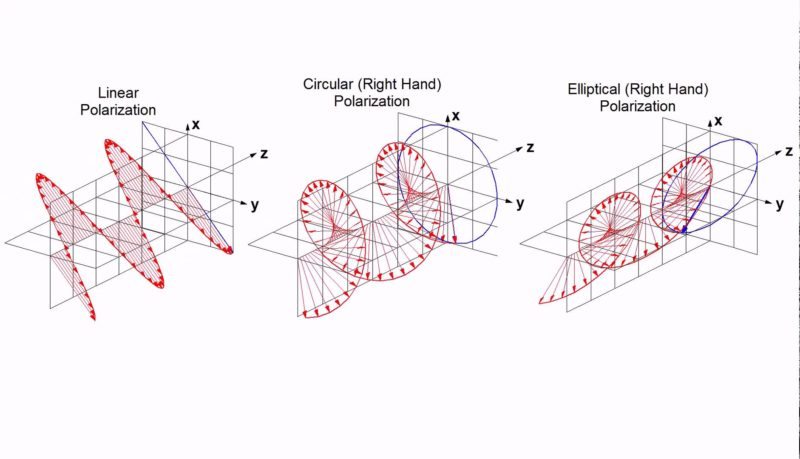Continued from Part 1. Here we talk about Polarisation.
Theoretically speaking, the waves should be accepted by the antenna and we should have an output. However reality is not so simple. The waves are affected by polarisation, resulting in some miscommunication of signal. RF antennas and the EM waves both undergo polarisation.
 For an electromagnetic wave, polarization is effectively the plane in which the electric wave vibrates. This is important when looking at antennas because they are sensitive to polarisation, and generally only receive or transmit a signal with a particular polarization. In an antenna, polarisation is in the same plane as the elements of the antenna. It is easy to determine since a horizontal antenna receives horizontally polarised signals and similarly for vertical antenna.
For an electromagnetic wave, polarization is effectively the plane in which the electric wave vibrates. This is important when looking at antennas because they are sensitive to polarisation, and generally only receive or transmit a signal with a particular polarization. In an antenna, polarisation is in the same plane as the elements of the antenna. It is easy to determine since a horizontal antenna receives horizontally polarised signals and similarly for vertical antenna.
Matching the polarisation becomes an important factor to have the best reception of signals. If the antenna polarisation does not matches with that of the signal, there is a decrease in the level of signal by a factor of cosine of the angle between the polarisation of the antenna and signal. If the two are cross polarisation with one another, then theoretically signal reception should not be possible.
However, some others factors have to be taken into consideration, when we look at real time signals. The final received signal is a combination of reflections from multiple surfaces, causing a change in polarization. Hence the final signal becomes a combination of various signals, with variations in parameters. This change is also observed in polarisation of the signal as well.
What is Polarisation?
Since it is making such a big issue with EM waves, let’s look at it in simple terms. In simple terms, the ability of waves to oscillate in more than one direction can be termed as polarisation. In an EM wave, both the electric and magnetic fields oscillate in different directions. Conventionally, the polarisation of light refers to the changes of electric field. Depending on the direction of the oscillations, we have certain categorisations.
|
Polarization is an important parameter in areas of science dealing with transverse wave propagation, such as optics, seismology, radio, and microwaves. Especially impacted are technologies such as lasers, wireless and optical fiber telecommunications, and radar. |
Box Source: Wikipedia
Classification
To define and understand it properly, we have certain categories that a wave undergoes. A broad classification would be linear and circular. Linear polarisation can be further subdivided into two categories, vertical and horizontal.
These are the simplest forms and are easy to understand. For eg. to generate a horizontal polarised wave, we could have an antenna axis horizontal to the earth. The electric field vector of the EM wave will be parallel to the earth. Similarly for a vector polarised EM wave, we could have an antenna vertical to the ground. The electric field vector is now perpendicular to the ground.
Circular polarisation however is a little complex. A comparison for understanding, could be a signal propagating from a rotating antenna. The signal would appear to be helical, as seen from the axis. This can again go either way. As seen from the transmitting antenna, left winding spiral, is a left circular polarised, whereas a right winding spiral is a right circular polarised wave.

Another form is elliptical polarisation. This would be more close to the real life situations of the signals. It occurs due to a mix of linear and circular polarised waves. A visualisation for the wave would be the tip of the electric field vector tracing an elliptical path in propagation.
Reception at the antenna
At the reception end, the story is however not as ideal as theory. Since polarisation requires setting up of antenna at the transmission end, same is true at the reception end. But unlike a linearly polarised antenna transmitting linearly polarised waves, a receiver can receive other polarised signals as well. Looks like a receiver is the AB+ of signals.
The factor to note however here is that, the signals received would be below 3 dB levels. Which would mean the signal would be very weak, and hence would not the best option to go for while designing a system. Similar is true for any signal reception. The signal reception is optimum for polarisation match of wave and antenna.
We discuss other important parameters involved in antenna design in part 3






